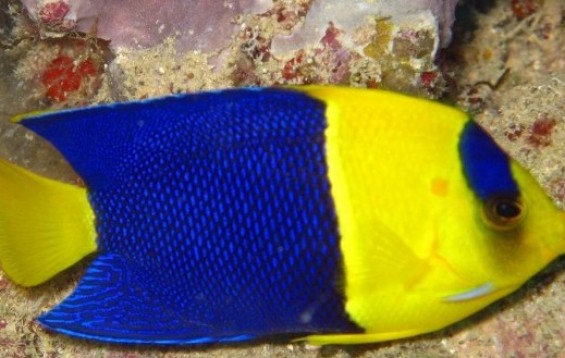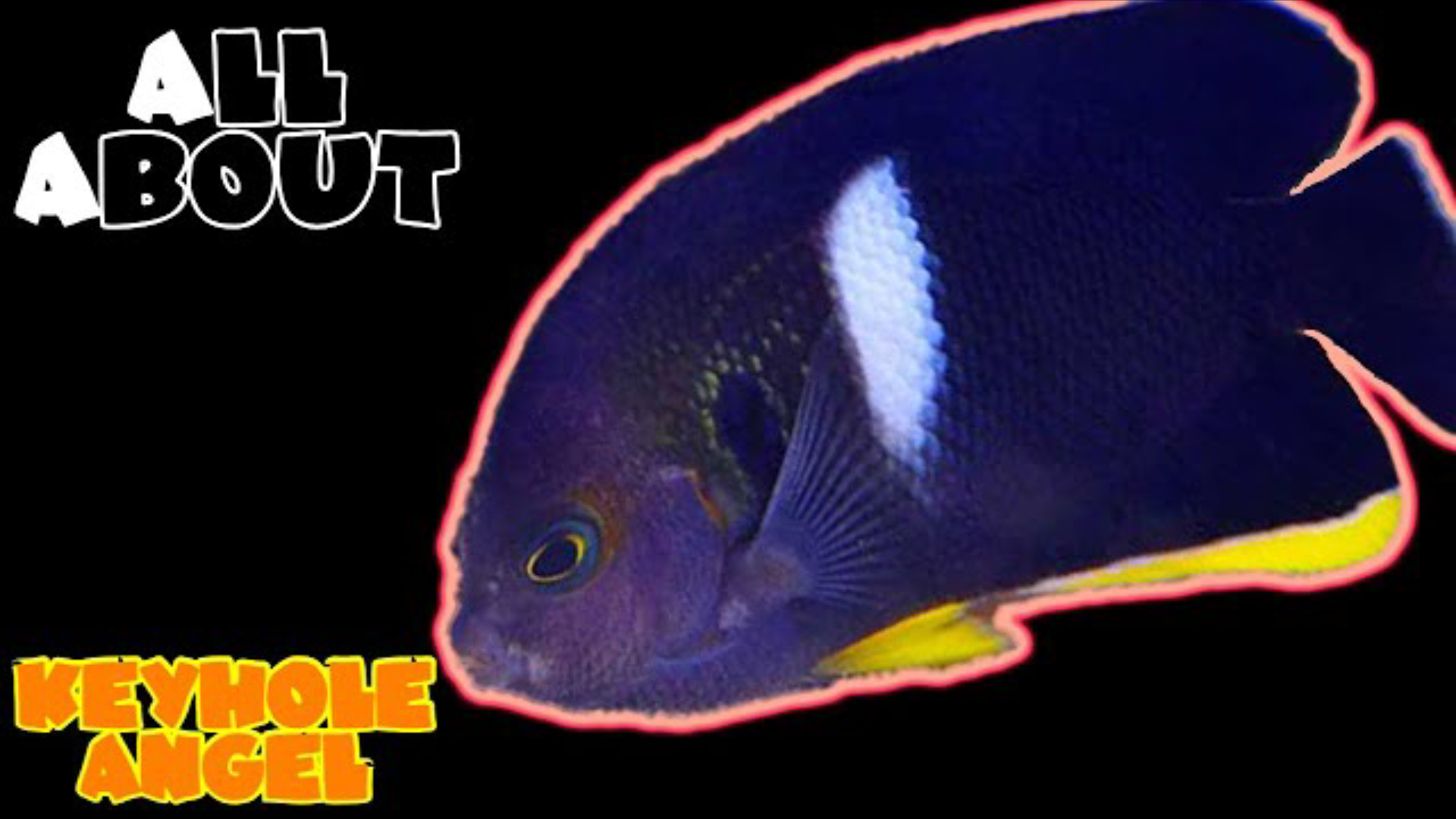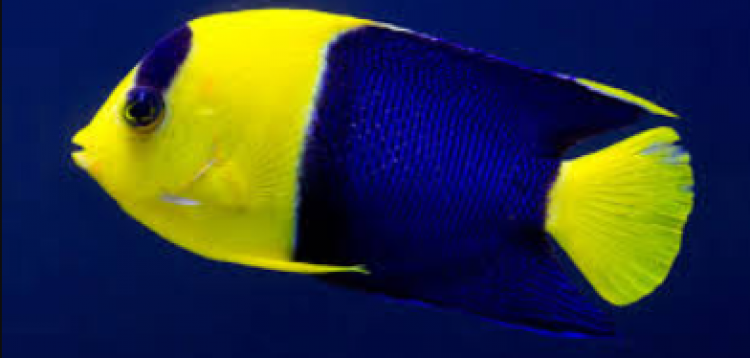- Name:
Bicolor Angelfish
(View AKA's) - Family: Pomacanthidae
- Species: Angel Dwarf
- Scientific Name: Centropyge bicolor


General info about Bicolor Angelfish
Thought by many to be the most striking of the Centropyge group of dwarf or pygmy angelfish, the Bicolor Angelfish is a vibrant yellow on the anterior half of its body and a deep blue on the posterior half. A splash of deep blue extends upward vertically from the eye to the top of the head, and the tail is yellow. Not a good reef dweller, the Bicolor Angelfish is prone to nip at stony and soft corals (sessile invertebrates) and clam mantles.
Bicolor Angelfish Diet & Nutrition
Bicolor angelfish are known to be benthic omnivores. Their diet is mostly leaning towards the more fleshy food. About 30% of their diet consists of algae, but as it ages 70% of their nutrition will come from corals, crustaceans, polychaete worms, sponges and other invertebrates. Feeding should be according to age.
When keeping them in a reef tank, it is best that they are fed a variety of living, frozen, and prepared formula food. Prepared formula food consists of spirulina algae, mysis, shaved fish or frozen shrimp, and angelfish food with sponge material.
Bicolor angelfishes should be fed 2 to 3 times a day depending on the size of the tank and the amount of natural algae source. Larger tank size and more natural algae source can decrease feeding time to 1 to 2 times per day.
Determining Sex of Bicolor Angelfish
Centropyge bicolor or Bicolor Angelfish are protogynous fishes, which means they are sequential hermaphrodites or organisms that are born as female and at some point of their lifespan changes sex into a male. For this species, sex reversal occurs for 18 to 20 days.
As with other protogynous species, male are larger than their female counterparts. Further, Bicolor Angelfish males have a distinguishing dark line through and under the eyes during courtship.
Breeding & Spawning Bicolor Angelfish
It is difficult to breed Bicolor Angelfish in captivity, however, in the wild, it may reach sexual maturity at 2.4 to 2.7 inches (60 to 69 mm). A dominant male will court and spawn with most of the mature females in the harem on most evenings from November to March. Spawning of Centropyge bicolor typically consists of the male and female circling each other, followed by the male making grunting noises. From the bottom, the male will swim upwards and hover while tilting its body toward the female at a 45-90 degree angle.
The female, once ready to spawn, will follow the male and soar together. Eggs and sperm will then be released to the water column for external fertilization. Once done, the pair will break apart for the male to find the next receptive female.
Common Diseases with Bicolor Angelfish
Bicolor angelfishes are susceptible to the common reef scourges such as parasites like White Spot Disease (Cryptocaryon irritans) or also known as Crypt, and Velvet Disease (Oodinium occelatum) which is a parasitic skin flagellate.
It is also vulnerable to bacterial and fungal diseases as a secondary infection from the parasitic and protozoan diseases. One major bacteria of concern is the Vibrio bacteria. It usually starts as an infection that turns into Dropsy, Popeye, Bleeding or Red Streaks on the skin. It is a very fast acting bacteria that can kill the fish within two days.
Bicolor Angelfish Origin
Centropyge bicolor is a largely populated and highly distributed species within the Indo-Pacific region. Ranging from East Africa to the Samoan and Phoenix Island, north to southern Japan, south to New Caledonia, and throughout Micronesia. It can also be found in Fiji Islands, Indonesia, Vanuatu, and in some parts of the Great Barrier Reef in Australia.
Caution with Bicolor Angelfish
Bicolor angelfishes are one of the most aggressive dwarf fishes and should be added last to any tank system. The advisable tank size for this species should be closer to 75 gallons allowing them to have their territory thus preventing the need to attack everyone that happens to swim by.
Bicolor angelfishes can be kept with larger semi-aggressive fish that will not be bullied, but not too large as to avoid being preyed on. It can also be kept with other dwarf angelfish that are different in color, size, and shape only in tanks that are 100-150 gallons.
Acclimating Bicolor Angelfish
Addition of live rocks with plenty of hiding space near the bottom of the tank is helpful in keeping Bicolor angelfish. These rocks should have algae growing on it before adding the fish. The tank should be up and running for at least six months before adding the Bicolor Angelfish. Fish from this species should be added to the tank at the same time or as the last addition. If more than one fish is to be housed in the same tank system, the smaller sized fishes should be added first by a few weeks followed by the larger ones.
Acclimitization time is approximately 30 minutes to 3 hours.
Original Detail
| Name | Species | Family | Scientific Name | More Detail | Added by |
|---|---|---|---|---|---|
| Bicolor Angelfish | Angel Dwarf | Pomacanthidae | Centropyge bicolor | Thought by many to be the most striking of the Centropyge group of dwarf or pygmy angelfish, the Bicolor Angelfish is a vibrant yellow on the anterior half of its body and a deep blue on the posterior half. A splash of deep blue extends upward vertically from the eye to the top of the head, and the tail is yellow. Not a good reef dweller, the Bicolor Angelfish is prone to nip at stony and soft corals (sessile invertebrates) and clam mantles. |
Admin |
Changed by users
| Submitted Date | Submitted By | Status | Action |
|---|



